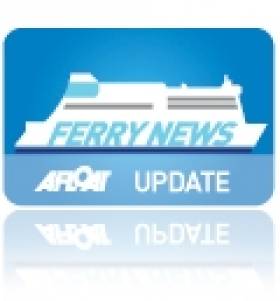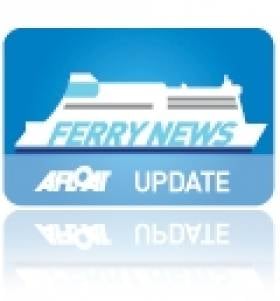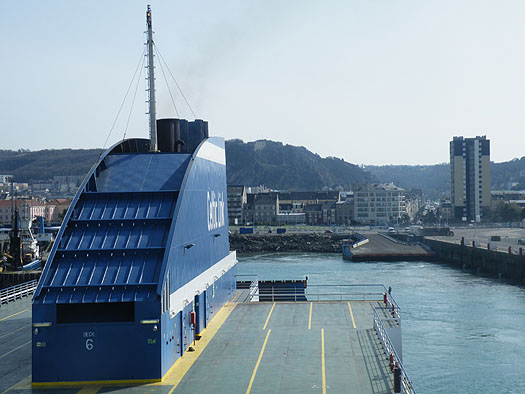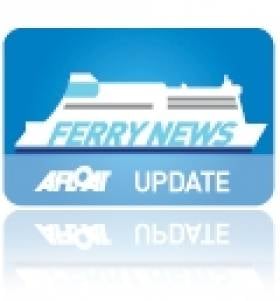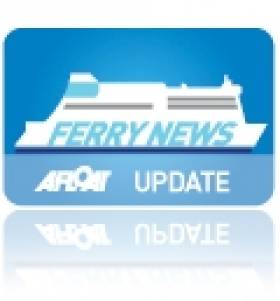Displaying items by tag: Stena Line
Stena Set Sails and Passenger Sales
#StenaTALLSHIP – One associates, Stena Line primarily with ferries operating across the Irish Sea, however through a division of the Stena Group, Northern Marine Management are responsible for the UK brig STA Stavros S. Niarchos, writes Jehan Ashmore.
The 59m vessel which berthed in Dublin Port today and is due to depart tomorrow is coincidental in timing as Stena Line's acquisition of Celtic Link Ferries is effective as also of today, with their first sailing tomorrow when the Tall Ships Youth Trust Sail vessel also heads out to sea.
Northern Marine Management also manages a diverse range of merchant shipping in their portfolio of more than 130 vessels including very large crude carriers (VLCC).
The Clydebank based ship, crew, and technical service management company earlier this year formed Northern Marine Ferries, which today added the former Celtic Link ro-pax Celtic Horizon to its book of vessels that they are managing for Stena Line's Irish Sea fleet.
#StenaHorizon – Northern Marine Management, part of the Stena Group, which earlier this year formed a separate ship management division for their Irish Sea fleet will be incorporating the former Celtic Link ro-pax Celtic Horizon, which was handed over today, writes Jehan Ashmore.
As previously reported, the Stena Line acquisition of Celtic Link Ferries will see the new ferry division, Northern Marine Ferries, bring the Italian flagged and built 27,555 tonnes vessel to be renamed Stena Horizon into the fold of the company's fleet. The Visentini built 940-passenger / 200-car/ 130-truck vessel will continue to operate the year-round Rosslare-Cherbourg service. Her first sailing is tomorrow from Irish port.
The Wexford port is also where Stena Europe serves Fishguard and the introduction of the French route newcomer represents an important milestone for the history of Stena Line of more than 50 years. This is the first time Stena will be able offer a direct Ireland-continent link.
The route's previous owners, Celtic Link in late 2011 chartered Celtic Horizon, on a five-year term charter from her shipbuilders Visentini outside Venice, where she was launched in 2005. She belongs to a very successful design of fast ro-pax vessels to be found employed in most European waters.
They are primarily for transporting freight ro-ro units and with up to 1,000 passenger capacity in limited facilities compared to conventional and cruiseferry style services. However, Stena Line invested in a £4m upgrade to improve passenger and truck-driver facilities of their slightly larger Visentini built sisters, Stena Lagan and Stena Mersey on the Belfast-Birkenhead (Liverpool) route.
#FarewellCelticLink - Celtic Link Ferries final farewell sailing arrived into Rosslare this morning from Cherbourg, marking an end of the era as the Wexford based company are been acquired by Stena Line with effect today, writes Jehan Ashmore, who travelled on board the ro-pax Celtic Horizon.
The last crossing was in command of Captain Richard Collins and his crew of 50 that operate services on board the 27,522 tonnes Visentini shipyard-built ro-pax. The 17-hour continental route will continue to maintain a sailing schedule of three return-crossings weekly when Stena Line rename the vessel for their first sailing tomorrow.
As Celtic Horizon bade farewell to Cherbourg yesterday afternoon, she cast her moorings alongside the former trans-Atlantic liner terminal, now the maritime and undersea exploration visitor attraction 'La Cité de la Mer'.
On board Celtic Horizon where excited French teenage students that occupied the uppermost deck drenched in 18-degrees sunlight and to the sound of the ship's horn marking her final departure.
Asides the countless coach based students that have travelled since Celtic Link began reinstating the service in 2005, after P&O Ferries abandoned the route the previous year, the company has catered for a diverse market that includes passengers on foot and in cars, camper-vans and motorcyclists.
In respect to freight, this involved un-accompanied freight-units and trucks notably carrying livestock trade, in which 18 such large trucks were conveyed on yesterday's sailing to Cherbourg during the busy calve season. Over the years there have been contracts to import French manufactured trade vehicles.
Of primary importance is fish exports to French, Spain, Italy and beyond, this was one of the major reasons why the owners of Celtic Link, the O'Flaherty brothers (and local investors) who operate a fish processing plant in Kilmore Quay and fleet of more a dozen trawlers purchased P&O's service.
Celtic Ferries departs Cherbourg Photo Jehan Ashmore
The deal had involved the route's existing freight-vessel European Diplomat, which incidentally formed part of the Falklands Task Force in 1982, however as Celtic Link's 'Diplomat' she served a limited passenger service for Celtic Link. She was displaced by ro-pax Norman Voyager which last week started new Brittany Ferries Économie services.
In 2011 Celtic Horizon which is the same ro-pax design of Norman Voyager, entered service on a five-year charter from the Italian shipyard owners to Celtic Link.
Celtic Horizon became the first and only vessel during the last nine years of the ferry company to be given a name reflecting her trading route and her owner's brand name displayed on her funnel.
Watch this space... with further reports from Afloat.ie's dedicated Ferry News section.
Stena Line Adjust Dublin-Holyhead Sailing Timetable
#StenaLine – An adjusted timetable has been announced for the passenger and freight ferry Stena Adventurer on Stena Line's Dublin Port-Holyhead route with effect from this Sunday 30 March.
The daily 21:15hrs sailing from Dublin Port will now depart at the slightly earlier time of 20:30hrs each evening - all other sailings on the Dublin Port – Holyhead route will remain unchanged.
Richard Horswill, Stena Line's Head of Freight UK and Ireland said: "Following regular communication with our customers, we have taken their feedback onboard and the Stena Adventurer will now depart each evening at 20:30hrs – 45 minutes earlier than before."
"The key benefit for our freight customers will be arriving in Holyhead 45 minutes earlier at 00:01hrs which will be a great advantage and benefit for our customers with early morning time sensitive deliveries to their customers throughout Great Britain. In addition, it will also improve the journey times for those customers making Landbridge connections," Richard continued.
For further information and details go to www.stenalinefreight.com or contact: 0870 850 3535
#NewTimetable – The Belfast-Liverpool (Birkenhead) timetable of Stena Line's 'freight' ferry service operated by Stena Hibernia has been adjusted to better suit the needs of its customers.
The service will now start the week from Belfast at 15.00 on a Monday. The ferry company has identified Monday afternoon as a key sailing time for its customers and the vessel now departs from Belfast on Mondays at 1500hrs.
Richard Horswill, Stena Line's Head of Freight UK and Ireland said: "Stena Line introduced the Stena Hibernia in November 2013 to complement the Stena Lagan and Stena Mersey to help cope with increased demand for freight capacity on this route.
"We have had a fantastic response from our customers to the new service and I am delighted to report that this demand has continued. We are working with our customers to ensure we develop the service to meet their needs and with this in mind, the first sailing of the week will now leave Belfast at 15.00hrs on a Monday instead of 03.00hrs on a Tuesday from Liverpool," Richard continued.
The Stena Hibernia, which has capacity for 12 drivers and 110 unaccompanied units representing an additional 1,680 lane metre capacity, operates eight sailings per week, giving freight customers greater availability and choice.
Dublin Ferryport Opens Up 'French Connection' Coincidence
#FerryConnection - By coincidence Irish Ferries new French route's ferry Cartour Epsilon shares Dublin Port's main ferry terminal with a rival ferry that also operated on the same route more than a decade ago, writes Jehan Ashmore.
That ferry is Stena Line's ro-pax Stena Nordica, which previously served P&O Ferries as their European Ambassador for two seasons in 2002 and 2003 on the Dublin-Cherbourg route in which Irish Ferries only re-opened in January.
With yesterday's announcement of Stena Line acquiring Celtic Link Ferries operations between Rosslare and Cherbourg, the Normandy port is the common denominator in these French connections to Wexford and the Irish capital. Incidently, prior to Celtic Link operating the route P&O had also ran this link to France.
Stena Nordica currently operates the Dublin-Holyhead route in tandem with Stena Adventurer. During her career with P&O for whom she was built in 2000, the European Ambassador was launched firstly on the Dublin-Liverpool route. The ro-pax was later switched to a second UK route port, by using a then newly constructed Welsh port of Mostyn on the Dee Estuary that shares the border with England.
European Ambassador would operate the Welsh route during the week and at weekends make a round-trip on the French service. On occasions she would make en-route calls to Rosslare. Likewise, Cartour Epsilon, which as previously reported also called to the Wexford port albeit on initial sailings last month for a contract to import trade vehicles.
The use of European Ambassador as single-ship serving two routes is similar to Irish Ferries 'Epsilon' running weekday sailings to Holyhead and at weekends to Cherbourg.
Unlike Stena Line's two-ship serviced Dublin-Holyhead route, Irish Ferries operate three vessels, flagship Ulysses, Epsilon and fast-ferry Jonathan Swift.
Stena Line Acquire Celtic Link Ferries Direct Continental Route
#StenaBuyCeltic- Stena Line has acquired the Irish-owned Celtic Link Ferries service which operates the Rosslare-Cherbourg route.
Celtic Link currently provides a three times weekly service between Ireland and France with the MV Celtic Horizon, which can accommodate 1 000 passengers, 200 cars and 120 freight units.
Ian Davies, Stena Line's Route Manager (Irish Sea South) said: "The acquisition of the Rosslare-Cherbourg route is a key strategic investment for Stena Line and one which will help stimulate and strengthen new and existing opportunities for trade and tourism between Ireland, France and beyond. With confidence in the Irish economy strengthening, we see positive long term growth in tourist and freight traffic from the Continent as a real opportunity to help strengthen this economic growth further. The Celtic Horizon will continue to operate a year- round service and we look forward to introducing the Stena Line experience to the vessel for our customers to enjoy."
Michael McGrath, Stena Line's Chief Operating Officer commented: "This exciting investment represents an important milestone for Stena Line as for the first time in our history we will be able to offer a direct ferry link between the Republic of Ireland and the Continent. We believe we can bring significant added value to the route with our wealth of industry experience and award winning customer service standards which we are confident will help to stimulate increased traffic volumes in the future."
The all year round service currently operates three weekly sailings from Rosslare at 21.30 on Tuesday and Thursday with a Saturday sailing at 16.00. From Cherbourg the schedule is 21.00 on Wednesday and Friday with a Sunday sailing at 16.00 with a journey time of approx 17 hrs.
Final details are currently being concluded around the acquisition and Stena Line hopes to be in a position to take over the running of the service with effect from Monday 31st March 2014.
Ferry Refit Brings Added Passenger Capacity and Facilities
#FerryRefit- Stena Adventurer, one of two Stena Line ferries operating the Dublin Port-Holyhead route has completed an extensive refurbishment which includes increased passenger capacity.
The refit, which sees enhanced and additional passenger facilities, has enabled the Stena Adventurer to increase capacity from 1200 to 1500 passengers. The boost to capacity is welcome news for customers travelling during peak sailings, especially during this busy Christmas and into the New Year season.
Stena Shopping is bigger and better than before with more wall space giving passengers even more products and great value deals to choose from with up to 40% savings compared to the high street.
The Stena Plus lounge also has additional capacity with more seating for extra comfort, while deck 7 has been transformed to offer a brand new area for passengers to eat, drink and relax with a Metropolitan Bar & Grill restaurant, a new comfortable seating area, movie lounge and children's play area.
Extra features will also be added to deck seven and eight later this month with a Hologram Guide and an Interactive Wayfinder on each deck which will enable help customers to navigate their way around the ship and find out more about meal deals and special offers.
Ian Davies, Route Manager Irish Sea South said: "We are delighted that the extensive refit on the Stena Adventurer has been completed and we can now offer our customers an even greater travel experience than before. The additional capacity also allows us to help more customers get the sailings they want.
"The new and improved passenger areas offer customers more places to relax onboard and with a larger shop there are even more bargains to choose from. What's more, we now offer a greater choice of dining options for passengers to enjoy really good, great value meals.
HSS Fastcraft Back for Christmas
#HSSreturns – The festive season will bring thousands of people driving home for Christmas with the return of the HSS Stena Explorer on the Holyhead-Dun Laoghaire service for 12 days.
The fastcraft's Christmas service on the Stena Line route will run between 20-23 December, 27-30 December and in the New Year between 2-5 January. The additional sailings will provide people travelling to Britain and Ireland to visit family and friends, enjoy a short break or take advantage of New Year sales.
The 2 hour 20 minute service will operate to a single round-trip schedule on the selected dates listed above with departures from Holyhead at 10.30am and sailings from Dun Laoghaire at 1.30pm.
Fastcraft facilities include a children's play area and entertainment, free Wi-Fi and festive movies and wonderful dining options. The onboard shop has offers of up to 40% savings compared to high street prices on a wide range of cosmetics, jewellery, spirits and fragrances.
Stena Line's Head of PR and Communications, Diane Poole said: "We are delighted to be bringing back the Stena HSS Explorer over the Christmas period. We always experience extra demand at this time of year, so the additional capacity will be of great help to customers. The HSS also brings with it its own unique brand of style and comfort plus the additional option of Dun Laoghaire port.
"Everyone deserves a break this Christmas and taking the ferry is the perfect way to travel as people can look forward to a stress free experience, arriving at their final destination relaxed and ready for the celebrations ahead.
High demand for Christmas sailings is expected and customers are advised to book early for the best fares and to secure preferred sailings.
Ferries Take Turns to Dry-Dock in Birkenhead
#FerriesDryDock - Stena Europe which stood in to cover Dublin-Holyhead route sailings by Stena Nordica, is currently in dry-dock at Cammell Laird, Birkenhead, writes Jehan Ashmore.
The dry-docking of the Stena Europe had already been scheduled and as previously reported is not related to the recent false alarm of a fire during a Dublin-bound sailing last week.
Likewise Stena Nordica had also dry-docked at Cammell Laird, where the ro-pax spent the last two days of November. She has since resumed her roster on the central corridor route which is also served by Stena Adventurer.
Notably, RFA Fort Rosalie (A385), the London registered Royal Fleet Auxiliary fuel replenishment tanker is also berthed at the shipbuilding and repair facility on the Wirral Peninsula.



























